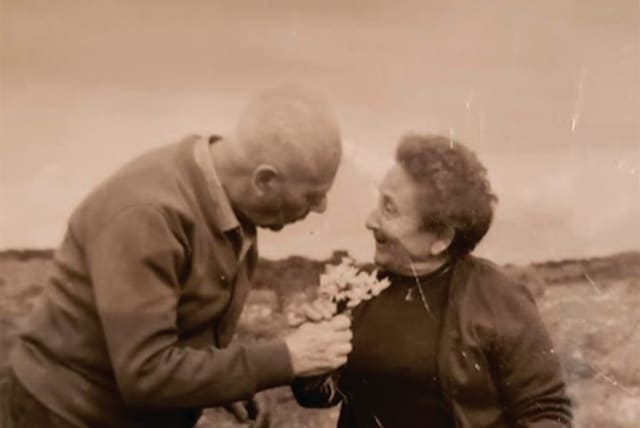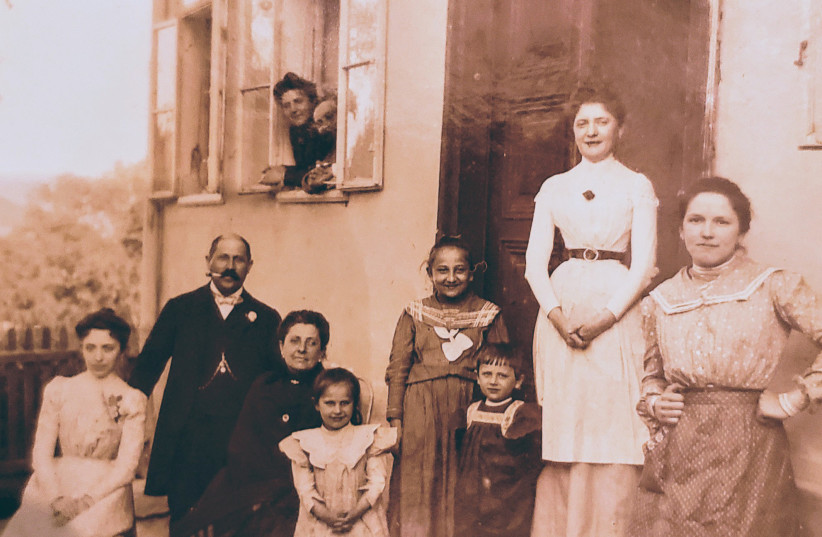Rudolphina Menzel: Zionist dog training pioneer

A new book on the Jewish woman who made her mark in the dog training world, creating the precursor to the IDF’s Oketz unit.
In the increasingly fast-paced world of 24/7 news and 140-character tweets, every once in a while it is both refreshing and a pleasure to receive a reminder of the benefits of studying a subject more in depth. Such was the case with a riveting lecture that I attended last Thursday evening at the Leo Baeck Institute.
The event was held to mark the launch of a new book, Canine Pioneer: The Extraordinary Life of Rudolphina Menzel, edited and partially written by Susan Martha Kahn, along with chapters by Monika Baar, Rachel Koriat, Binyamin Blum, Lea Lehavi, Myrna Shiboleth and Tammy Bar-Joseph.
As an inveterate dog lover and owner of three beautiful dogs, I found the subject matter to be one of particular interest. However, even for non-dog lovers, Menzel herself is enough to pique one’s interest, not least because of her formidable character, especially at a time when being a woman and, even more so, a Jewish woman didn’t help in making one’s mark in the world, particularly in what was the male-oriented field of working with dogs.
Rudolphina’s beginnings
Born into a bourgeois family in Vienna in 1891, Rudolphina did not automatically conjure up the image of being an expert cynologist (as I learned during the lecture, this is the term for people focusing on all topics relating to dogs, from their evolution to canine breeding and training).
As a teenager, Rudolphina found herself drawn to both Zionism and socialism, although as she grew older she found it harder to reconcile these two interests, particularly in the Europe of the early 20th century. Eventually, Rudolphina resisted the offer of becoming a leader in the Social Democratic Party, due to her connection to Zionism and the desire to immigrate to Israel.
Rudolphina studied chemistry at the University of Vienna, where she enrolled in the Theodor Herzl Zionist College Students Club. This was to change her life, as this was where she met a medical student who would later become her husband, the aptly named Rudolph Menzel, with whom she had a genuine and complementary partnership in both their personal and professional lives for the 55 years of their marriage. Rudolphina completed her PhD in 1914, and she and Rudolph married in 1916, not long after World War I broke out.
After the war ended, Rudolphina and Rudolph settled in Linz, the location of Hitler’s childhood home, where there was a small Jewish community of approximately 900 people. Rudolph worked as a doctor, but Rudolphina needed to find a new source of employment, as Linz did not offer the same opportunities for pursuing a professional career as a chemist as Vienna had. Once again, Rudolphina became active within the Austrian Social Democratic Party, but insisted on joining as a proud Jew. She also began to deliver public lectures on Zionism, as she felt that the local Jewish groups were not sufficiently Zionist.
Interest in canines sparked
It was in Linz where Rudolphina adopted her first dog, a Doberman Pinscher puppy, which sadly died of canine distemper after a few days. She then adopted a boxer puppy, which she named Mowgli, which was to change the course of her and Rudolph’s lives, and became the first of hundreds of dogs that the couple would own and train. As a woman barely five feet tall who knew absolutely nothing about dogs, it is hard to picture Rudolphina handling a muscular and boisterous boxer puppy!
However, Rudolphina was to quickly overcome her lack of knowledge of the canine world and became a voracious reader of dog-training techniques, which she then taught Mowgli.
Rudolphina’s love of Zionism was even incorporated into her dog training, as she insisted on training Mowgli in Hebrew, a practice that she would adhere to throughout her working career, regardless of where the dogs were located.
As she would later work with dogs trained for the Austrian and German armies (prior to World War II), I have to admit to being amused by the fact that the Austrian and German military officers would have to learn Hebrew commands in order to communicate with their dogs trained by Rudolphina! Such was the esteem with which she would be held in her field, that they had no choice but to acquiesce to this.
In fact, despite the precarious times in which they lived, both Rudolphina and Rudolph made no secret of their Jewishness. Rudolphina also chose to name her kennels Bnei Satan, the Hebrew for “Children of Satan”!
Filling the literary void
Despite being so esteemed in her field and almost solely responsible for introducing dog training to pre-state Palestine, including developing the precursor to Oketz (the IDF canine unit) and the Israel Institute for Orientation and Mobility of the Blind, the first school for guide dogs in the Middle East, surprisingly little had been written about Rudolphina Menzel.
This was about to change, as Susan Martha Kahn, an anthropologist by profession and associate director of the Harvard Law School program on Jewish and Israeli Law, would step in to fill this void.
As an anthropologist, Kahn has always been interested in the relationship between humans and animals, which led to her studying Bedouin and their animals.
Based in the US and unable to pursue her research in the field due to the outbreak of COVID in early 2020, she suddenly had a lot of free time on her hands. This reignited her desire to write a book about Rudolphina, something that she had wanted to do ever since she wrote a chapter on her and her relationship with dogs in a book titled A Jew’s Best Friend? 10 years earlier. Having access to Rudolphina’s German-language memoirs and all this free time led to Kahn painstakingly and meticulously typing hundreds of pages, word for word, into Google Translate to get an idea of what was in the memoirs!
The more that Kahn read about Rudolphina, the more she realized that she needed to talk to people working in the dog field. Discovering that many of them were also keenly interested in Rudolphina and her vast contribution to cynology in Israel and internationally, Kahn reached the conclusion that it would be a good idea to bring them all together and work on a book focusing on her.
While the book provides a fascinating and much-needed introduction to the monumental role that Rudolphina played in making the field of cynology such a respected and important field, as well as entwining dogs into the fabric of Israeli society, Kahn readily admits that there is much more material still to be covered.
The book
The chapters of Canine Pioneer, written by different authors, focus on Rudolphina’s life and background, perspectives on her legacy, her invention of modern dog culture in Israel, training working dogs in pre-state Palestine, and her reintroduction of the Canaan dog breed to Israel, as well as her portrayal in Israeli culture.
One of the characteristics that Kahn most admires about Rudolphina is that despite the many upheavals in her life, she was constantly reinventing herself and was indefatigable in acquiring new skills and changing direction when necessary. Even when she was effectively demoted in the IDF in 1948 after having trained hundreds of working dogs, due to being a middle-aged German woman whose European accent made it difficult to understand sometimes, rather than admit defeat and rest on her laurels, she went on to establish Israel’s first school for guide dogs. Her reputation preceded her, and Helen Keller came to Israel to open the school in 1952.
Having visited Palestine in 1934 and 1937, where they held many meetings, lectures and dog-training courses, Rudolphina and Rudolph were not total strangers to the land when they decided to emigrate in 1938, having come to the sad realization that they were no longer safe in Austria. Despite this and their love of Zionism, it was not easy for them to leave behind their friends, all their dogs bar two, and the kennels in which that they had invested so many years.
Upon arrival in Palestine in 1938, they settled into a modest apartment in Kiryat Motzkin, near Haifa. Shortly after, they established the Palestine Research Institute for Canine Psychology and Training, from where Rudolphina would oversee all canine activities in the country, such as advising on veterinary health and dog breeding, offering dog-training courses, and researching and publishing her scientific research.
One of the biggest challenges that the couple faced was the lack of trainable dogs, having left most of their dogs behind in Austria. Undeterred, the couple eventually managed to capture stray dogs from a rubbish dump on the outskirts of Tel Aviv by tempting them with food scraps. Rudolphina also used her canine networks to provide more dogs, carrying out temperance tests on them to determine whether they were suited to be guard dogs. Gradually, Rudolphina realized that she would have to create a framework for breeding dogs with known pedigrees in order to continue to meet the demand for trainable dogs. Together with the Palestine Kennel Club, she began to record the origins and lineages of every pedigree dog in the country in breed-specific stud books.
In the 1940s, Rudolphina and Rudolph created a national association for service dog trainers and began to organize dog shows and service dog performances. Rudolphina invited the wives of British police officers to be judges, and their shared love of dogs helped to develop connections with British Mandate officials. As a result, the British requested her help in training mine-detecting dogs during World War II. She agreed, after receiving official permission from Moshe Sharett (who would later become Israel’s second prime minister) and a promise from the British that the dogs she provided would not be used against Jews in the Yishuv.
Alongside Rudolphina’s training of military and service dogs, it was also important to her to encourage people’s familiarity with, and love of, dogs – not always an easy task in a mainly Jewish population where dogs were traditionally regarded as unclean or, more recently, were associated with the trauma of World War II, dogs having been used by the Nazis to instill fear in people. Therefore, in 1953, she decided to create the Canaan dog breed, which became the national dog breed of Israel, from which many Israeli dogs today are descended, including two of my own. If Meshi, my part-Canaan dog, is anything to go by, Canaan dogs are extremely friendly but also incredibly stubborn, perhaps not unlike Israelis themselves!
While it is hard to do justice to both Rudolphina and the book Canine Pioneer: The Extraordinary Life of Rudolphina Menzel in one article, it provided a fascinating insight into the dedication and passion of one woman toward dogs and toward Zionism.
Rudolphina’s combination of her two passions and her vast achievements in cynology, overseas and upon moving to Israel, serve as a fitting example of women’s contributions to society. ❖
Jerusalem Post Store
`; document.getElementById("linkPremium").innerHTML = cont; var divWithLink = document.getElementById("premium-link"); if (divWithLink !== null && divWithLink !== 'undefined') { divWithLink.style.border = "solid 1px #cb0f3e"; divWithLink.style.textAlign = "center"; divWithLink.style.marginBottom = "15px"; divWithLink.style.marginTop = "15px"; divWithLink.style.width = "100%"; divWithLink.style.backgroundColor = "#122952"; divWithLink.style.color = "#ffffff"; divWithLink.style.lineHeight = "1.5"; } } (function (v, i) { });

